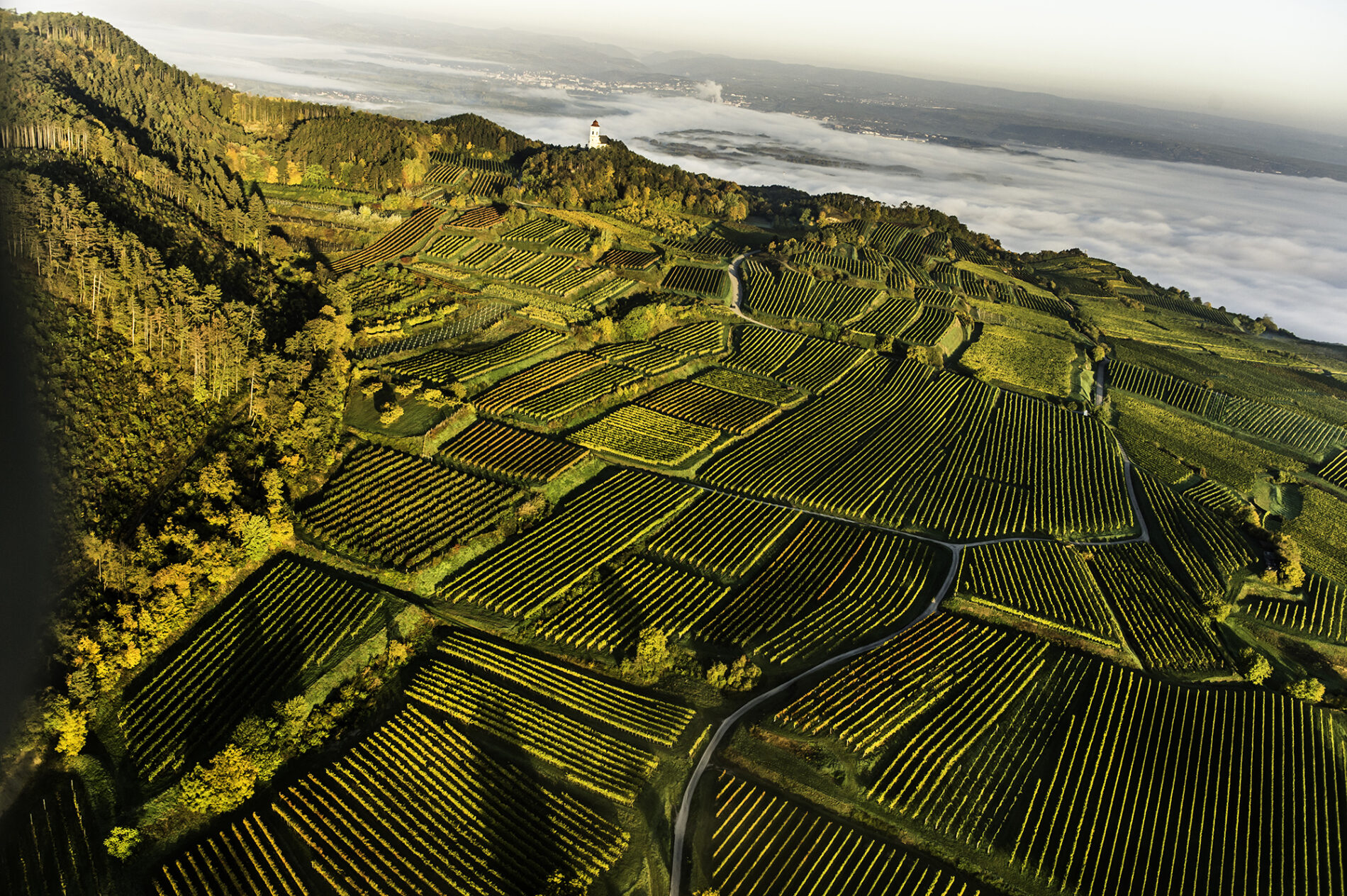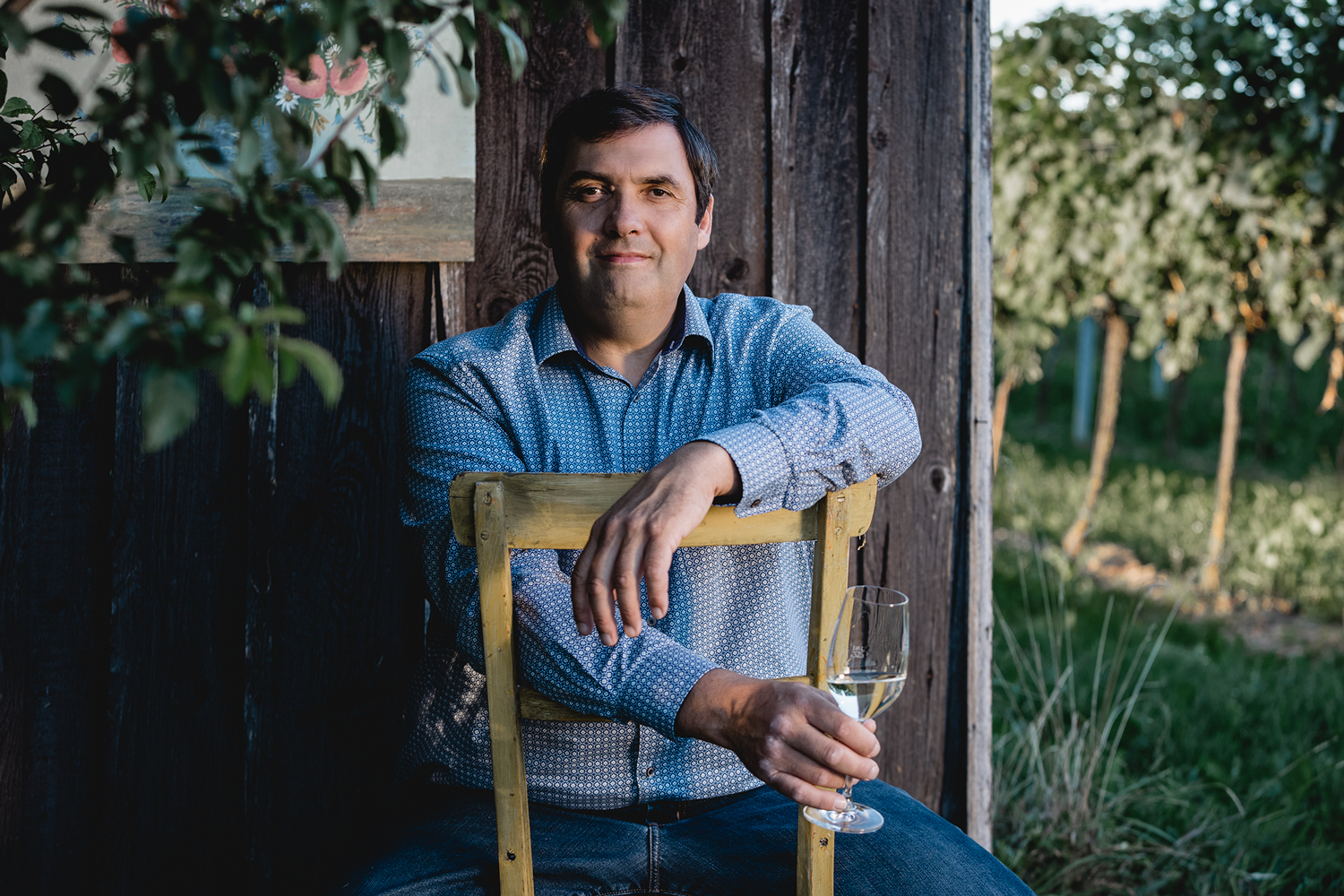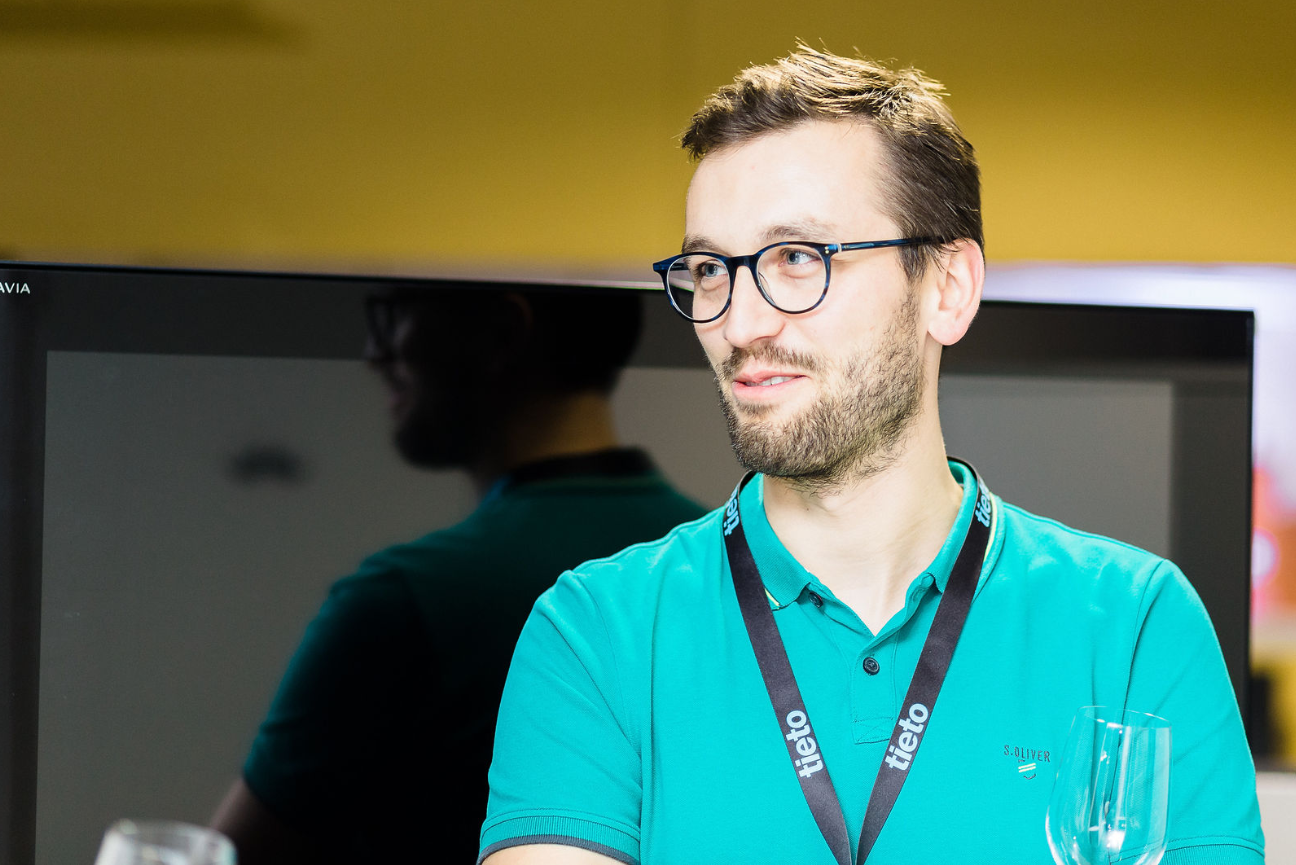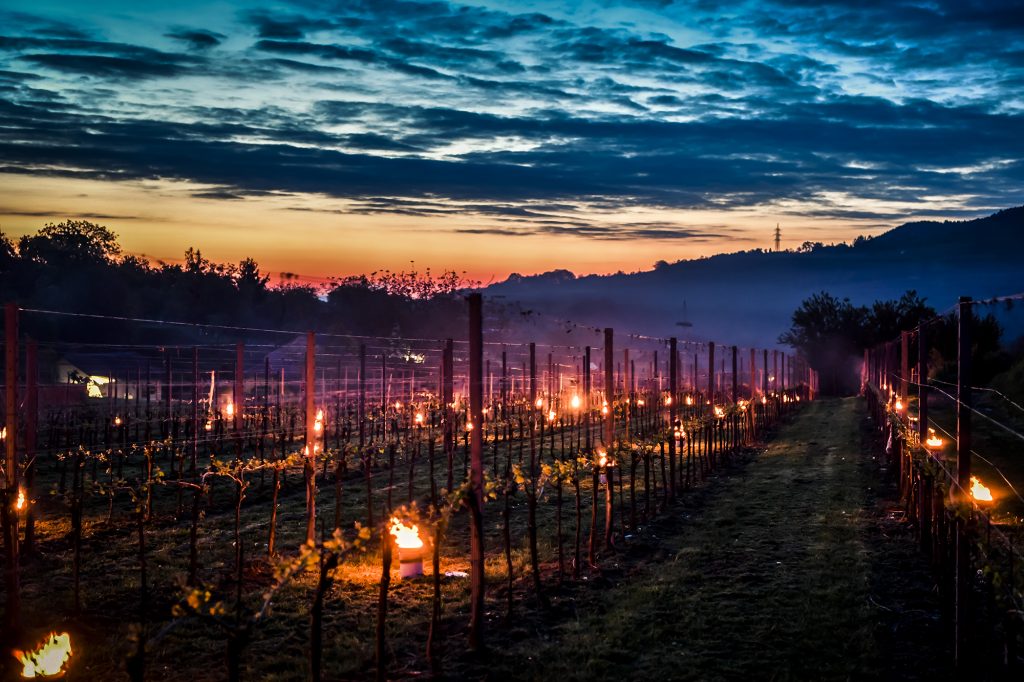
Saving the wine, one grape at a time, from the perils of late-season frost caused by climate change
Rudi Hofmann spent years working in the wholesale wine business before deciding to follow his dream to own a vineyard and winery. About 20 years ago, he started BioWeingut Hofmann, and took up wine growing on 37 acres along the steep, terraced banks of the Traisen River in eastern Austria. The area’s claim to fame, in particular, is Grüner Veltliner, a white wine grape noted for its fruity and full-flavored taste.
And while wine drinking may be for relaxation, wine growing is not. It involves long hours, hard physical labor, keeping a constant eye on the weather, and combatting problems such as pests, mildew and fungus. In recent years, because of climate change, a new threat has surfaced: Late-season frost.

“Frost itself has always been a problem,” Hofmann says. “If the crops are in their early stages and there is frost, you’re only losing some buds of the vine blossoms; you don’t lose the whole harvest. Due to climate change, vegetation is starting earlier and then if you have frost in the spring, and you have grapes flowering – then you could lose everything.”
In 2017, late-season frost damage cost Austrian vineyards and fruit orchards an estimated 70 million euros (more than $60 million dollars). To see if technology could help, the European Innovation Partnership for Agricultural productivity and Sustainability (EIP-AGRI) – whose mission is to contribute to the European Union’s strategy for sustainable growth – and the Austrian Federal Ministry of Agriculture, Regions and Tourism formed a working group called ARGE FrostStrat. Its members include government, educational and research organizations, technology companies and growers, including Hofmann.
The result: A pilot project that places sensors in risky areas of vineyards and orchards to record information including temperature, humidity and topography. The data is sent to the Microsoft Cloud and – combined with weather prediction models and machine learning in Microsoft Azure – provides growers with detailed 48-hour forecasts about the exact time late-season frost is expected on their land. That gives growers a jump-start to begin protecting their grapes and orchards against late-season frost.
The advance notice is important because it takes time, effort and money to put that protection into place, and there are several ways to do it. They range from using helicopters to hover over fields, with the helicopter’s blades pushing warm air down to the ground to help raise the temperature, to using what are known as “frost candles” – large paraffin candles placed around the crops to increase the temperature. Not every grower or farmer can afford helicopters. And using frost candles can be expensive as well.
“One goal of the project is not only to measure the data, and to provide the data to growers, but also to compare the different preventive strategies, like the candles or the helicopters or sprinkler systems – how much do they cost and which one brings the best result?” says Johannes Strassmayr, senior consultant at TietoEVRY, a global digital services and software company that created the early warning system.

Hofmann will be eager to learn that information as well. His winery produces around 100,000 bottles a year, “which in Austria is considered a mid-sized winery,” he says. “But on a global scale, it’s a very small winery.”
Still, it carries large-size expenses. It costs around 1,000 euros an hour per hectare (which is about 2.47 acres) to use the paraffin candles. “So if you know in advance you can delay using them by an hour, for example, it is a significant savings,” he says.
Late-season frost used to happen only occasionally, Hofmann says, but in his area, it has occurred the last seven years in a row. “Combined with the earlier start of the vegetation, the risk of damage keeps increasing,” he says.
Christian Hofmann, Rudi’s brother, says historically when growers dealt with frost, they drove in the middle of the night “like maniacs through their vineyards to measure temperatures manually and decide when and where to activate their heating.” It is not the most efficient way to go about things, says Hofmann, who is a member of the ARGE FrostStrat group.
“One of the farmers says he was driving 1,000 kilometers a week in a small, small area – basically, driving all night long to take temperatures in different spots to know which areas had early indicators for frost,” Christian Hofmann says. With the FrostStrat service, they can now monitor their land remotely.
“I said, ‘What if you could surveil your vineyards from your smartphone, sitting back home, and if everything goes well, you just continue sleeping, or having a good glass of wine with your friends?’ This is the kind of story behind the genesis of this project.”
The system “not only provides real-time and forecast data for all sensor locations but also sends text or email alerts to growers’ and farmers’ smartphones,” says Strassmayr.
Global warming has affected not only wine growing, but also apricot, apple and peach orchards in Austria. With budding happening earlier in the season, it leaves crops more vulnerable to the effects of late-season frost.
The problem isn’t specific to Austria, which is among the top 10 wine producers in Europe. This year, in France – the No. 1 producer in Europe and one of the top producers worldwide – the country’s wine-growing output was down 29 percent, a historic low, because late-season frost “cut down a good part of the production,” the French Ministerial Statistical Service for Agriculture said in September.
According to the World Weather Attribution initiative, human-caused climate change made the damaging frost event in France about 60% more likely. The Proceedings of the National Academy of Sciences (PNAS) in the U.S. found that if temperatures rise as expected by 2 degrees Celsius, regions of the world that are suitable for growing wine grapes could shrink by as much as 56 percent.

“In some ways, wine is like the canary in the coal mine for climate change impacts on agriculture, because these grapes are so climate-sensitive,” said one of the authors of the 2020 PNAS study.
TietoEVRY, which is headquartered in Finland, put the monitoring system into place in September 2019. The pilot project will end in September 2022, when all the data will be evaluated.
“We set up a collection of cloud services in Azure that we call an accelerator platform and can easily adopt new use cases from customers even beyond agriculture,” says Strassmayr.
“It doesn’t matter if the sensors are somewhere outdoors in a field, or somewhere in a construction site or a manufacturing site. The processing is basically always the same. The scale differs of course. Here we have, for now, 300 sensors in the fields in Austria, but in a manufacturing center, you might have thousands of sensors in hundreds of places all over the world.”
TietoEVRY Austria set up a similar kind of system for two large Austrian companies that supply materials for construction industries, and together, have more than 200 production sites and over 3,200 production lines. The system is helping them increase overall efficiency by measuring production data.

The ARGE FrostStrat project “is one use case for a specific agricultural area, but there are thousands of use cases where we can help to make everybody’s life easier and simpler with such solutions,” says Robert Kaup, TietoEVRY Austria general manager.
“The feedback from the participating farmers shows us how valuable a digital early warning system, intelligent measurements and small-scale forecasts are.”
“Digital transformation is rapidly evolving even in conservative sectors like agriculture,” says Jutta Grabenhofer, Microsoft Austria sustainability lead, who is working with TietoEVRY on the pilot. “While there is the perception that only large-scale producers can benefit from digital technology, this use case shows that smaller businesses also can benefit from using IoT and data analytics to increase efficiency.”
Christian Hofmann says monitoring programs like ARGE FrostStrat’s may also help shape the future of how agricultural land – a finite resource – is used.
“There are long-term decisions to be made about things like the raw usage of land that historically have been decided upon based on intuition or gut feelings, or because ‘it has always been that way,’” he says. “That has led to over-consumption of irrigation, heating and infrastructure – you name it, because we don’t use the facts. And climate change is so rampant that most of the ‘old wisdom’ is not relevant anymore. The data that we’re collecting here helps to drive the emotions out of the decisions, which is always tough. It’s a second perspective that should not be underestimated.”
Rudi Hofmann agrees. As an organic wine grower, he wants to continue following his dream with his winery, but he wants to do it more smartly and sustainably.
“What I see for the future is that we will know much more about the data in our vineyards, and we have the possibility to produce more sustainable crops than we do at the moment, than we did the last century,” he says.
“We have to plant the right fruit on the right place, and then we have to monitor it, and take actions in the right moment with the minimum of impact to the environment.”
Top photo: Lower Austria is one of the main wine-growing areas in the country. The area is located north and west of Vienna. Photo courtesy of Rudi Hofmann.
